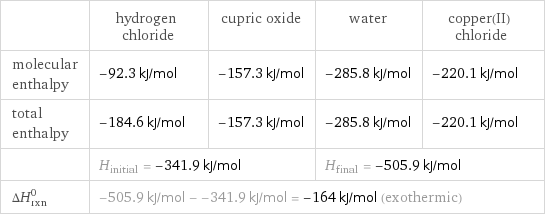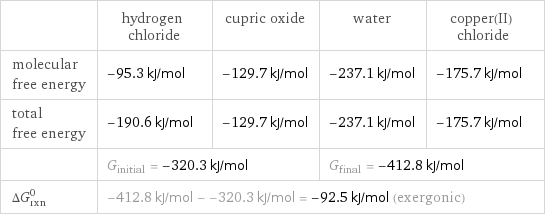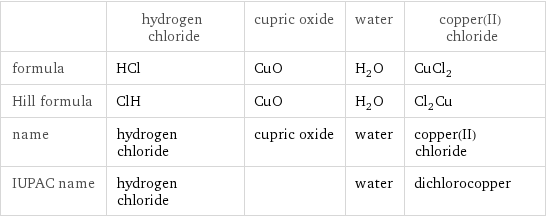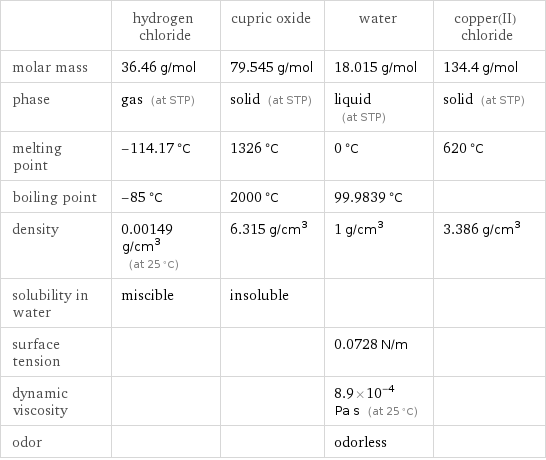Input interpretation

HCl (hydrogen chloride) + CuO (cupric oxide) ⟶ H_2O (water) + CuCl_2 (copper(II) chloride)
Balanced equation

Balance the chemical equation algebraically: HCl + CuO ⟶ H_2O + CuCl_2 Add stoichiometric coefficients, c_i, to the reactants and products: c_1 HCl + c_2 CuO ⟶ c_3 H_2O + c_4 CuCl_2 Set the number of atoms in the reactants equal to the number of atoms in the products for Cl, H, Cu and O: Cl: | c_1 = 2 c_4 H: | c_1 = 2 c_3 Cu: | c_2 = c_4 O: | c_2 = c_3 Since the coefficients are relative quantities and underdetermined, choose a coefficient to set arbitrarily. To keep the coefficients small, the arbitrary value is ordinarily one. For instance, set c_2 = 1 and solve the system of equations for the remaining coefficients: c_1 = 2 c_2 = 1 c_3 = 1 c_4 = 1 Substitute the coefficients into the chemical reaction to obtain the balanced equation: Answer: | | 2 HCl + CuO ⟶ H_2O + CuCl_2
Structures

+ ⟶ +
Names

hydrogen chloride + cupric oxide ⟶ water + copper(II) chloride
Reaction thermodynamics
Enthalpy

| hydrogen chloride | cupric oxide | water | copper(II) chloride molecular enthalpy | -92.3 kJ/mol | -157.3 kJ/mol | -285.8 kJ/mol | -220.1 kJ/mol total enthalpy | -184.6 kJ/mol | -157.3 kJ/mol | -285.8 kJ/mol | -220.1 kJ/mol | H_initial = -341.9 kJ/mol | | H_final = -505.9 kJ/mol | ΔH_rxn^0 | -505.9 kJ/mol - -341.9 kJ/mol = -164 kJ/mol (exothermic) | | |
Gibbs free energy

| hydrogen chloride | cupric oxide | water | copper(II) chloride molecular free energy | -95.3 kJ/mol | -129.7 kJ/mol | -237.1 kJ/mol | -175.7 kJ/mol total free energy | -190.6 kJ/mol | -129.7 kJ/mol | -237.1 kJ/mol | -175.7 kJ/mol | G_initial = -320.3 kJ/mol | | G_final = -412.8 kJ/mol | ΔG_rxn^0 | -412.8 kJ/mol - -320.3 kJ/mol = -92.5 kJ/mol (exergonic) | | |
Equilibrium constant
![Construct the equilibrium constant, K, expression for: HCl + CuO ⟶ H_2O + CuCl_2 Plan: • Balance the chemical equation. • Determine the stoichiometric numbers. • Assemble the activity expression for each chemical species. • Use the activity expressions to build the equilibrium constant expression. Write the balanced chemical equation: 2 HCl + CuO ⟶ H_2O + CuCl_2 Assign stoichiometric numbers, ν_i, using the stoichiometric coefficients, c_i, from the balanced chemical equation in the following manner: ν_i = -c_i for reactants and ν_i = c_i for products: chemical species | c_i | ν_i HCl | 2 | -2 CuO | 1 | -1 H_2O | 1 | 1 CuCl_2 | 1 | 1 Assemble the activity expressions accounting for the state of matter and ν_i: chemical species | c_i | ν_i | activity expression HCl | 2 | -2 | ([HCl])^(-2) CuO | 1 | -1 | ([CuO])^(-1) H_2O | 1 | 1 | [H2O] CuCl_2 | 1 | 1 | [CuCl2] The equilibrium constant symbol in the concentration basis is: K_c Mulitply the activity expressions to arrive at the K_c expression: Answer: | | K_c = ([HCl])^(-2) ([CuO])^(-1) [H2O] [CuCl2] = ([H2O] [CuCl2])/(([HCl])^2 [CuO])](../image_source/54fce634d91d93560f6df4228e02fe62.png)
Construct the equilibrium constant, K, expression for: HCl + CuO ⟶ H_2O + CuCl_2 Plan: • Balance the chemical equation. • Determine the stoichiometric numbers. • Assemble the activity expression for each chemical species. • Use the activity expressions to build the equilibrium constant expression. Write the balanced chemical equation: 2 HCl + CuO ⟶ H_2O + CuCl_2 Assign stoichiometric numbers, ν_i, using the stoichiometric coefficients, c_i, from the balanced chemical equation in the following manner: ν_i = -c_i for reactants and ν_i = c_i for products: chemical species | c_i | ν_i HCl | 2 | -2 CuO | 1 | -1 H_2O | 1 | 1 CuCl_2 | 1 | 1 Assemble the activity expressions accounting for the state of matter and ν_i: chemical species | c_i | ν_i | activity expression HCl | 2 | -2 | ([HCl])^(-2) CuO | 1 | -1 | ([CuO])^(-1) H_2O | 1 | 1 | [H2O] CuCl_2 | 1 | 1 | [CuCl2] The equilibrium constant symbol in the concentration basis is: K_c Mulitply the activity expressions to arrive at the K_c expression: Answer: | | K_c = ([HCl])^(-2) ([CuO])^(-1) [H2O] [CuCl2] = ([H2O] [CuCl2])/(([HCl])^2 [CuO])
Rate of reaction
![Construct the rate of reaction expression for: HCl + CuO ⟶ H_2O + CuCl_2 Plan: • Balance the chemical equation. • Determine the stoichiometric numbers. • Assemble the rate term for each chemical species. • Write the rate of reaction expression. Write the balanced chemical equation: 2 HCl + CuO ⟶ H_2O + CuCl_2 Assign stoichiometric numbers, ν_i, using the stoichiometric coefficients, c_i, from the balanced chemical equation in the following manner: ν_i = -c_i for reactants and ν_i = c_i for products: chemical species | c_i | ν_i HCl | 2 | -2 CuO | 1 | -1 H_2O | 1 | 1 CuCl_2 | 1 | 1 The rate term for each chemical species, B_i, is 1/ν_i(Δ[B_i])/(Δt) where [B_i] is the amount concentration and t is time: chemical species | c_i | ν_i | rate term HCl | 2 | -2 | -1/2 (Δ[HCl])/(Δt) CuO | 1 | -1 | -(Δ[CuO])/(Δt) H_2O | 1 | 1 | (Δ[H2O])/(Δt) CuCl_2 | 1 | 1 | (Δ[CuCl2])/(Δt) (for infinitesimal rate of change, replace Δ with d) Set the rate terms equal to each other to arrive at the rate expression: Answer: | | rate = -1/2 (Δ[HCl])/(Δt) = -(Δ[CuO])/(Δt) = (Δ[H2O])/(Δt) = (Δ[CuCl2])/(Δt) (assuming constant volume and no accumulation of intermediates or side products)](../image_source/df4eac1938a96befbcb71eb72d7f43ed.png)
Construct the rate of reaction expression for: HCl + CuO ⟶ H_2O + CuCl_2 Plan: • Balance the chemical equation. • Determine the stoichiometric numbers. • Assemble the rate term for each chemical species. • Write the rate of reaction expression. Write the balanced chemical equation: 2 HCl + CuO ⟶ H_2O + CuCl_2 Assign stoichiometric numbers, ν_i, using the stoichiometric coefficients, c_i, from the balanced chemical equation in the following manner: ν_i = -c_i for reactants and ν_i = c_i for products: chemical species | c_i | ν_i HCl | 2 | -2 CuO | 1 | -1 H_2O | 1 | 1 CuCl_2 | 1 | 1 The rate term for each chemical species, B_i, is 1/ν_i(Δ[B_i])/(Δt) where [B_i] is the amount concentration and t is time: chemical species | c_i | ν_i | rate term HCl | 2 | -2 | -1/2 (Δ[HCl])/(Δt) CuO | 1 | -1 | -(Δ[CuO])/(Δt) H_2O | 1 | 1 | (Δ[H2O])/(Δt) CuCl_2 | 1 | 1 | (Δ[CuCl2])/(Δt) (for infinitesimal rate of change, replace Δ with d) Set the rate terms equal to each other to arrive at the rate expression: Answer: | | rate = -1/2 (Δ[HCl])/(Δt) = -(Δ[CuO])/(Δt) = (Δ[H2O])/(Δt) = (Δ[CuCl2])/(Δt) (assuming constant volume and no accumulation of intermediates or side products)
Chemical names and formulas

| hydrogen chloride | cupric oxide | water | copper(II) chloride formula | HCl | CuO | H_2O | CuCl_2 Hill formula | ClH | CuO | H_2O | Cl_2Cu name | hydrogen chloride | cupric oxide | water | copper(II) chloride IUPAC name | hydrogen chloride | | water | dichlorocopper
Substance properties

| hydrogen chloride | cupric oxide | water | copper(II) chloride molar mass | 36.46 g/mol | 79.545 g/mol | 18.015 g/mol | 134.4 g/mol phase | gas (at STP) | solid (at STP) | liquid (at STP) | solid (at STP) melting point | -114.17 °C | 1326 °C | 0 °C | 620 °C boiling point | -85 °C | 2000 °C | 99.9839 °C | density | 0.00149 g/cm^3 (at 25 °C) | 6.315 g/cm^3 | 1 g/cm^3 | 3.386 g/cm^3 solubility in water | miscible | insoluble | | surface tension | | | 0.0728 N/m | dynamic viscosity | | | 8.9×10^-4 Pa s (at 25 °C) | odor | | | odorless |
Units
